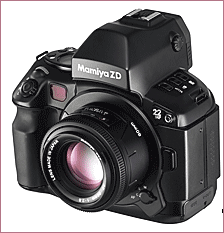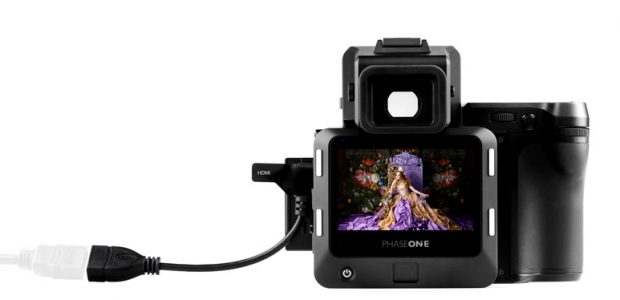
At 22 months, elephants have the longest gestation period of any mammal. We don’t yet know what the average gestation period for all-in-one medium format digital cameras might be, since the breed is still too new. But that of theMamiya ZDcan now be noted as something like 18 months, fromPhotokinaannouncement in September 2004, to first shipment in Europe in March, 2006.Pentaxis also in the gestation race, having first announced its 645 medium format DSLR in June of 2005. Current word is that it will be shown in final form at this September’sPhotokina, and ship before year’s end. That will mean roughly an 18 month gestation period as well. Maybe we’re seeing a trend.
This of course begs the question –why so long? Could it be simply that we are being told about these products at the point that they are just wooden mockups, and that this is the normal time to birth. I think not, because in the case of the ZD, Mamiya have been showing working samples for more than a year, and some 40 pre-production samples were floating around Japan and Europe last summer.
No, the issue seems to be more complex than that. Part of the problem, I am sure, is that going from a third-party sensor and support electronics to a camera able to produce high quality images is definitely a non-trivial matter. In the medium format arena there are only a handful of companies with this expertise –Leaf,Phase One, andImaconbeing the primary ones. Each has earned its experience in this area over nearly a 10 year period, and they each hold patents on various aspects of image processing technology, and hard-won development firmware and software in pursuit of image excellence. For a company like Mamiya or Pentax to make just a camera is to call upon decades of expertise, but to make adigital camerarequires a skill set and corporate experience that simply isn’t there to begin with, and which isn’t all that easy to acquire. (Note that the medium format back makers, till now, have all been European companies (Leaf’s R&D is Israeli, but we’ll make them honorary Europeans for this example). To be sure, companies likeCanonandNikonhave experience in this area, but they’ve been at it for years.
The other part of the problem, at least as far as the Mamiya ZD goes, is that Mamiya has had its ups and downs during the past year or so. It went though a financial reorganization last year, and this has to have taken a toll on the ZD project.
But, the ZD is now here (if you live in Asia or Europe), and so because its the first of its breed, it deserves a close look. ButMamiya America Corp. is strangely mum about the ZD. It has neither signaled that it will or it won’t ship the camera in the US market. Part of the problem may be that MAC is also theLeafmedium format back distributor in the US. There’s no way to know the extent to which politics is preventing MAC from releasing the ZD, but it is fair to wonder.
Nevertheless, there is huge interest in the ZD, especially among the thousands of photographers who own Mamiya lenses and who would like a migration path to digital. Yes, it only produces 12 bit files rather than the 16 bit files of the more expensive MF backs. Yes, it’s 22 Megapixels, in a pro environment where 33 – 39 Megapixel backs are becoming the new norm. But, at nicely under $15,000 it is well priced (or would have been a year ago), and so it engenders strong interest from pros and amateurs alike.
So – since the chances of my getting my hands on a ZD for review seem slim at the moment, I have put out a call for European photographers who have experience with the ZD to contribute their impressions and reviews. I am looking for professional photographers or advanced amateurs with prior expertise in DSLRs and medium format digital to contribute their reviews and observations.Contact me if you’d like to participate.
Last June (’05) I publisheda first look reportbyClaus Possberg. Today (March 11, ’06) I offer a hands-on report byDenis Montalbetti, a Sydney based commercial photographer who recently had an opportunity to work with a full production ZD. His report follows.
____________________________________________________________________________________
I shot with the Mamiya ZD camera about 3 weeks ago here in Sydney, Australia thanks to Maxwell’s (the agent for Mamiya in Australia). Overall I was impressed.
I used the Mamiya 645 AFD II body and have 4 lenses. During the test with the new Mamiya ZD, I shot using the 55-110 zoom with a Broncolor ring flash hand held!!!
I was amazed that it is lighter than the Canon 1DS II. I am a long time Canon user and have the new 5D which is a great camera. Since going digital over 5 years ago, I switched from shooting primarily 35 mm to medium format using the Mamiya 645 AFD with various digital backs (it took us no time at all to decide the Leaf digital backs were our favorite).
Back to the ZD…another thing I like about it is fast focus.. I shot at ISO 50 and the results were excellent. Because it is 12 bit the tonality is not as good as the Leaf Aptus 22. I use the Leaf Aptus 22 for most of our commercial work. The Mamiya ZD shoots quickly but when the buffer fills up it does slow down a bit.
When I was testing the Mamiya a few photographers came into the studio and shot with it as well. They shoot product and other work that doesn’t require a rapid shoot rate so they were impressed.
Although I prefer a faster capture rate (I shoot people), I still got what I wanted and loved it. I processed the raw files with the Mamiya software with took 35 SEC (G5 Mac 2.3 Dual processor 4 GIG ram) to convert a 16 bit file which I thought was very fast. We also processed the files in CS 2.
We are currently working with a company here, Baltronics, promoting the Leaf Aptus and also the new Mamiya 645 AFD II. I would love to have one of the ZD’s as an everyday camera and use the Canon less. I hope it is a success just for the sake of Medium format. I find the Hasselblad H1 very heavy (because of the weight of the lenses) and over priced. I my case I still prefer the contrast of Mamiya glass. The new Sinar M camera has impressive lenses (200 lines/mm).
So, overall I really liked the Mamiya ZD and would like to shoot with it again!
Cheers,
Denis Montalbetti – Montalbetti+Campbell
CANON AIPP Australian Advertising Photographer of the Year 2005
2/9 Moira Crescent,
Randwick, NSW
Australia 2031
Telephone: 61 2 9664 8520Email: mcphoto@iprimus.com.au
http://www.montalbetticampbell.com____________________________________________________________________________________
Yesterday I was asked to do some comparisons between my Phase One P45 and the new Mamiya ZD, and my reactions were no where near as positive as the short review given by Denis Montalbetti .
To be fair, I was comparing to the best digital back on the market, which I am sure you will agree, and on the back of a Hasselblad H1 outfit. The Hasselblad lenses alone are considerably better at resolving detail than any of the Mamiya 645 lenses, so the Mamiya was never going to be as impressive, but the difference is really quite pronounced. Apart from that, resolving highlights and shadow detail is another area that the Mamiya ZD performed quite poorly I think. The highlights burn out quite easily, and the shadow detail is well off that of the Phase One. Noise levels became very evident once the ISO reached 200 and above, and when comparing to a Canon 1Ds MK2, which is the obvious direct competition for such a complete camera, the Mamiya looked very ordinary indeed in the noise department.
Yet it is a compact and relatively light camera, and for those already owning Mamiya 645 lenses, it might well be a way for them to enter the digital arena by continuing on with the same brand.
If I was a person looking to make a decision on buying a Canon 1Ds Mk2 or the Mamiya, there would be little doubt about which way I would go, and save several thousand dollars in the process.
Regards,
Geoff Ross
Melbourne, AustraliaI specialize in landscape photography, selling prints, image usage, books and calendars. To get an idea of some of my work you can go towww.geoffrossphotography.comI have done a fair bit of travelling over the years, but since having the P45 and Hasselblad, I feel like I would like to re-shoot everything again! In addition to the Rolls-Royce of digital, I also shoot with a Canon 1Ds MK2 with Leica lenses. I don’t know that I’m obsessed with quality of capture, but my thinking is, if it’s worth taking, take it as best you can. Yet my prime focus is, and has always been, on "seeing" the image.
____________________________________________________________________________________
There is aNorwegian languageweb review of the Mamiya ZD online. Just click on the large photograph to see more.
The text may not be comprehensible, but the photographs speak for themselves.____________________________________________________________________________________
A review of a full production Mamiya ZD by Eduard de Kam is nowonline
Other reviews and commentary by those who gain experience with the Mamiya ZD are welcome.
You May Also Enjoy...
100 Fxxxing Megapixels – The Phase One XF Camera Reaches 100 MP – Early Hands One Report
By Michael Reichmann & Kevin Raber Sample Images For Downloading Can Be Found At The End Of This Article Michael's Initial Impressions of The Phase

